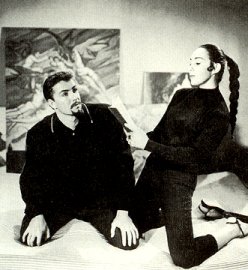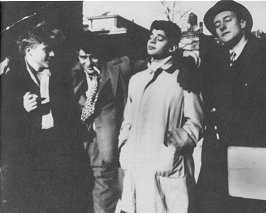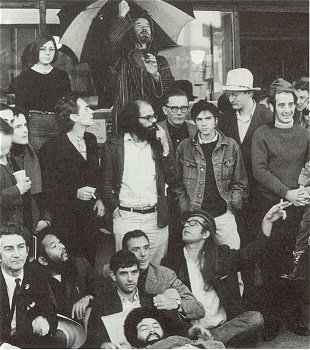
| Many times, when a person hears a reference to the Beat Generation, their mind conjures up the image of the archetypal beatnik - a goateed, pot-smoking, jive-talking, bongo-beating, beret-wearing, jazz-bopping guy dressed in all black. This inaccurate stereotype is often the only knowledge that people have of the Beats. True, there were many people in the 1950s and early 60s who attempted to be a part of this "hip new crowd" of poets and artists by dressing, speaking, and acting in such ways; however, these people were not truly Beat. They were the "beatniks" - a pejorative word coined by a San Fransisco columnist to describe the "new social type in American popular culture." (Watson, 257.) |  |
The true Beat Generation was quite different from this pop culture explosion. Rather than being a mass cultural force, the Beats were actually a realtively small group of friends and writers who encouraged and inspired each other's work.
 |
The Beat Generation was born in New York City in the early 1940s. It began with the meetings of William Burroughs, Allen Ginsberg, and Jack Kerouac, the "founders" of the literary movement. The three young writers, ranging in age from 17 (Ginsberg) to 29 (Burroughs), all felt like outsiders in the mainstream society of the day. This sharing of their art and their position in the world lead to the formation of deep bonds between them which would last for decades to come. |
The troupe of friends and writers, joined by many other enduring characters such as Neal Cassady, traveled across the country many times in the years between 1946 and 1954. The Beat ports of call included Denver, Texas, North Carolina, Louisiana, Mexico City, and Ecuador. In 1954, Burroughs traveled to Tangiers to escape the emotional and legal problems which plagued him in the United States, and Ginsberg and Kerouac made their way to San Francisco.
In San Francisco, another literary and artistic movement had been coalescing since the mid-1940s. Called the San Fransisco Renaissance, it had its roots in circles of poets, writers, intellectuals and social activists who gathered together for discussions on society, politics, and philosophy, poetry readings, and writing seminars. The Renaissance branched out to include many young, revolutionary poets and writers, including Michael McClure, Gary Snyder, Gregory Corso, Lawrence Ferlinghetti, Phillip Lamantia, Phillip Whalen, Robert Creely, and Bob Kaufman. The San Fransisco poets experminted in open form poetry. Like the Beats, they were largely also intersted in "confessional poetry, conciousness-expanding drugs, sexual liberation ... pacifism and liberatrian anarchism ... (and) Eastern religion, notably Buddhism and Taoism..." (Watson, 192.) Also similarly to the Beats of New York, the San Francisco poets were closely bonded, both through their writing and through their friendships.
The San Francisco Renaissance entered into high gear in October of 1955, triggered by the Six Gallery poetry reading. The reading was largely organized largely by Ginsberg (who was beginning to play a significant role in the San Francisco scene.) It included such poets as McClure, Lamantia, Snyder, Whalen, and Ginsberg himself, who delivered the first reading of his most well-known poem, "Howl." The Six Gallery reading was the catalyst for the flourishing of the San Francisco Renaissance. The poets and artists of the movement were spurred to more intense, daring and frequent creation, and the movement also received more attention from the outside media.
| This new attention from the outisde media helped the writers of the Beat Generation to finally get their work published, including Kerouac's On the Road, Burrough's Junky, and Ginsberg's "Howl" and Other Poems. However, the mass media attention also brought with it the popularization of the Beat culture, transforming it into "beatnik" culture as described above. As such bastardizations of the Beat movement appeared and began to take hold in American society, the Generation itself began to lose its steam. The writers began to disband, though some relationships remained solid and close for decades to come. Ginsberg, Kerouac, Burroughs and the other writers all continued to write and publish their works, to varying degrees of critical acclaim and success, throughout their lives. |  |
index - background: the beat generation - beat meets east - beat zen, beat tao - bibliography
1999, by j.r. aponte